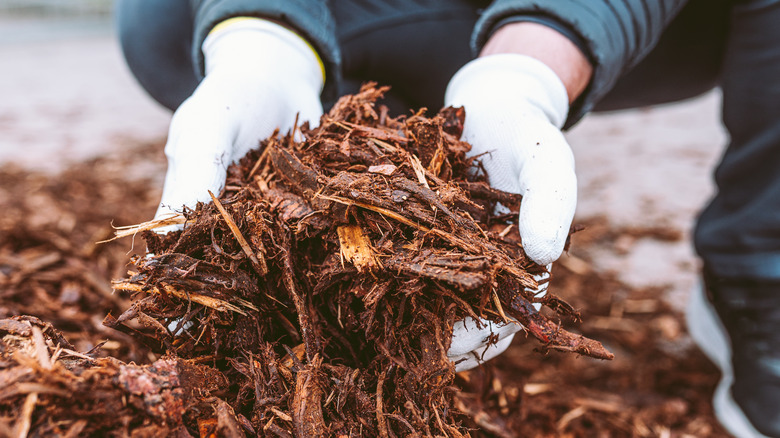The Old Farmer's Almanac Shares A Smart Tip For Healthier Hydrangeas
If you're lucky enough to enjoy blooming hydrangeas in your garden, there's one smart thing The Old Farmer's Almanac says you can do for them this fall. If you want healthier hydrangeas, protect them through the winter with a generous layer of bark mulch or pine needles. Like most plants, hydrangeas, no matter their cold tolerance, can be stressed by sudden or drastic fluctuations in temperature.
Cold tolerance among these plants varies depending on the different varieties of hydrangeas you have growing in your yard. Panicle hydrangeas (Hydrangea paniculata), the toughest kind, thrive in USDA Plant Hardiness Zones 3 to 9, and can even weather some drought. Big leaf, or French hydrangeas (H. macrophylla), are more cold-averse since they're only hardy down to zone 6. Oakleaf hydrangeas (H. quercifolia) and mountain hydrangeas (H. serrata) also rank among more tender cultivars since they're only hardy to zone 5.
Remember, too, that winter chill hurts hydrangeas in containers more than shrubs in the ground, no matter the variety. For all these plants, mulch becomes especially important in the winter. It really can be an insurance policy, even for hardier varieties, since no shrub is 100% immune to inclement weather that freezes its roots. That's why so many kinds of hydrangeas need special care in fall. Mulch insulates, but it also has other benefits, like making the soil more nutrient-rich. It regulates moisture, too, so that water doesn't drain too quickly for this thirsty plant.
Mulch your hydrangeas for healthier plants
To properly mulch your hydrangeas, gather bark mulch, pine needles, or straw. Leaves can work, too. Just don't choose maple leaves, since they tend to stick together and might smother this perennial plant. You want to get enough mulch to put down a layer that's anywhere from 8 to 18 inches thick. Pick any number of soil preparation tools to spread your mulch, but a hoe or a rake tends to work best. Keep mulch clear of the base of the shrub, giving it room to breathe, or you're just asking for fungal disease or root rot.
Once spring rolls around, you might want to thin out the mulch at the base to help the soil warm up a little faster. While you've got the rake out, think about augmenting the soil. Improve dense, clay soil with compost to help the water drain better. At the same time, train loamy or sandy soils to retain more moisture by adding leaf mulch.
For extreme bouts of cold weather, you could also wrap plants to protect them from winter chill. Use chicken wire to build a cage around them and fill it with leaves. You can also cloak the entire plant in burlap. Drive wooden stakes in the ground near the hydrangea and then drape the cloth on it like a cozy plant tent. Don't make a cover so tight that it causes damage.

